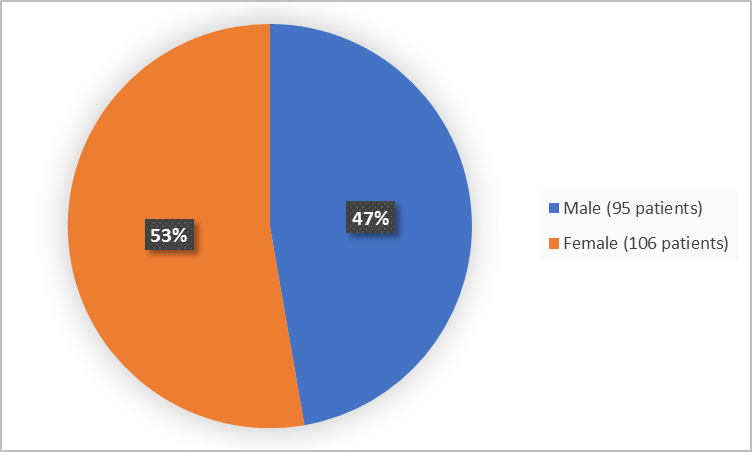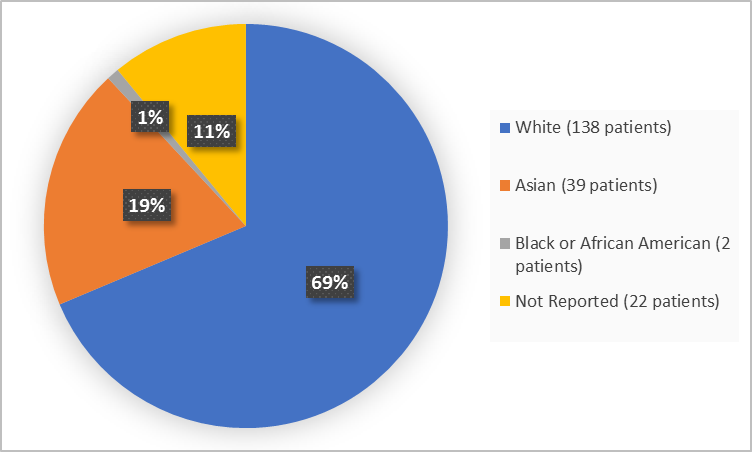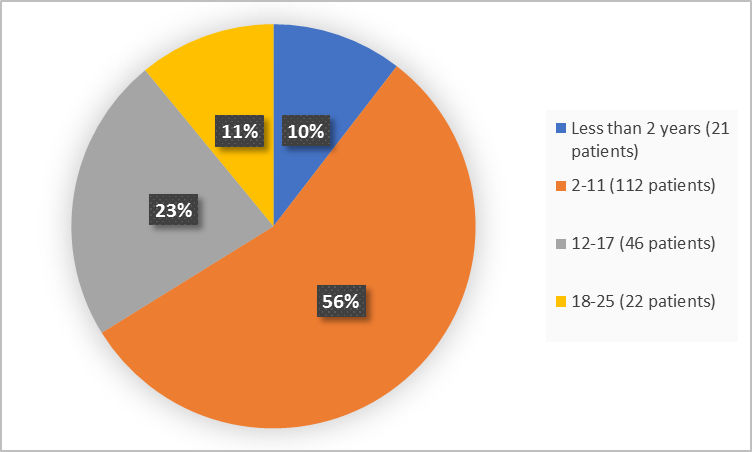Drug Trials Snapshots: EVRYSDI
HOW TO USE THIS SNAPSHOT
The information provided in Snapshots highlights who participated in the clinical trials that supported the FDA approval of this drug, and whether there were differences among sex, race, and age groups. The “MORE INFO” bar shows more detailed, technical content for each section. The Snapshot is intended as one tool for consumers to use when discussing the risks and benefits of the drug.
LIMITATIONS OF THIS SNAPSHOT:
Do not rely on Snapshots to make decisions regarding medical care. Always speak to your health provider about the risks and benefits of a drug. Refer to EVRYSDI Prescribing Information for complete information.
EVRYSDI (risdiplam)
ev ris' dee
Genentech Inc.
Approval date: August 7, 2020
DRUG TRIALS SNAPSHOT SUMMARY:
What is the drug for?
EVRYSDI is a drug for the treatment of spinal muscular atrophy (SMA) in patients 2 months of age and older.
Spinal muscular atrophy is a rare genetic disease that affects mostly children and young adults. It is caused by a low level of protein in the motor neurons that are responsible for normal muscle functioning. The lack of protein causes motor neuron loss, progressive muscle weakness, and may lead to premature death from respiratory failure.
How is this drug used?
EVRYSDI is taken as a liquid by mouth once a day after a meal. The amount of liquid is determined by the patient’s weight.
What are the benefits of this drug?
In one trial, 41% (7/17) of treated infants were able to sit without support for more than 5 seconds after 12 months of treatment with EVRYSDI.
In the second trial, patients treated with EVRYSDI, on average, improved muscle function after 12 months of treatment, while patients treated with placebo, on average, continued to deteriorate.
What are the benefits of this drug (results of trials used to assess efficacy)?
Efficacy results for individual trials are presented below.
|
In Trial 1, of the patients who were treated with the recommended dosage of EVRYSDI 0.2 mg/kg/day, 41% (7/17) were able to sit independently for ≥ 5 seconds (BSID-III, Item 22)* after 12 months of treatment. |
*Item 22 of the Bayley Scales of Infant and Toddler Development – Third Edition (BSID-III) gross motor scale)
The primary endpoint for Trial 2 was the change from baseline in the Motor Function Measure 32 (MFM32) total score at Month 12. The scale measures the neurologic impairment from 0-100 where lower scores indicate greater impairment.
Table 1. Summary of Efficacy in Patients at Month 12 of Treatment (Trial 2)
|
Primary Endpoint: |
EVRYSDI |
Placebo |
|
Change from baseline in total MFM32 score at Month 12, LS means (95% CI) 1,2,3 |
1.36 (0.61, 2.11) |
-0.19 (-1.22, 0.84) |
|
Difference from Placebo, Estimate (95% CI)1 |
1.55 (0.30, 2.81) |
|
1 The Mixed Model Repeated Measure (MMRM) analysis included the change from baseline total score as the dependent variable and as independent variables the baseline total score, treatment group, time, treatment-by-time interaction and the randomization stratification variable of age group (2 to 5, 6 to 11, 12 to 17, 18 to 25).
2 The MFM total score was calculated according to the user manual, expressed as a percentage of the maximum score possible for the scale (i.e., sum of the 32 item scores divided by 96 and multiplied by 100).
3 Based on the missing data rule for MFM32, 6 patients were excluded from the analysis (EVRYSDI n = 115; placebo control n = 59).
Adapted from EVRYSDI Prescribing Information
Were there any differences in how well the drug worked in clinical trials among sex, race and age?
- Sex: The differences in response to EVRYSDI between males and females could not be determined due to the overall small number of patients in the trial.
- Race: The number of patients in the overall clinical trial was small, and the majority of patients were White; therefore, differences in response to EVRYSDI among races could not be determined.
- Age: The differences among age groups could not be determined due to overall small number of patients. In addition, SMA is mostly a disease of children and young adults; therefore, it is not known how well EVRYSDI works in elderly patients.
Were there any differences in how well the drug worked in clinical trials among sex, race, and age groups?
The differences in response to EVRYSDI among sex, race, and age groups in Trial 2 are presented below.
Table 2. Subgroup Analysis of MFM32 at Week 52 by Sex
|
Subgroup |
Estimated Treatment |
Std. Error |
Lower 95% Confidence Limit |
Upper 95% Confidence Limit |
|
Female |
1.7393 |
0.9068 |
-0.05110 |
3.5297 |
|
Male |
1.3904 |
0.9010 |
-0.3885 |
3.1693 |
Table 3. Subgroup Analysis of MFM32 at Week 52 by Race
|
Subgroup |
Estimated Treatment |
Standard |
Lower 95% Conf |
Upper 95% Conf |
|
White |
2.4957 |
0.7603 |
0.9943 |
3.9970 |
|
Asian |
-2.0452 |
1.3803 |
-4.7708 |
0.6803 |
|
Others |
2.5804 |
1.7541 |
-0.8833 |
6.0442 |
Table 4. Subgroup Analysis of MFM32 at Week 52 by Age
|
Subgroup |
Estimated Treatment |
Standard Error |
Lower 95% Confidence Limit |
Upper 95% |
|
Age 2-<6 |
3.1371 |
1.1783 |
0.8105 |
5.4636 |
|
Age 6-11 |
1.5795 |
1.0943 |
-0.5812 |
3.7402 |
|
Age 12-17 |
1.0405 |
1.1892 |
-1.3075 |
3.3886 |
|
Age 18-25 |
-0.6451 |
1.7145 |
-4.0303 |
2.7402 |
FDA Statistical Review
What are the possible side effects?
The most common side effects of EVRYSDI are were fever, diarrhea, and rash. Additional common side effects in infants include respiratory tract infection, pneumonia, constipation, and vomiting.
What are the possible side effects (results of trials used to assess safety)?
Side effects occurring in Trials 1 and 2 are presented separately.
| Trial 1: The most frequent adverse reactions reported in infantile-onset SMA patients treated with EVRYSDI in Trial 2 were similar to those observed in later-onset SMA patients in Trial 2. Additionally, the following adverse reactions were reported in ≥ 10% of patients: upper respiratory tract infection (including nasopharyngitis, rhinitis, respiratory tract infection), pneumonia, constipation, and vomiting. |
Table 5. Adverse Reactions Reported in ≥ 5% of Patients Treated with EVRYSDI and with an Incidence ≥ 5% Greater Than on Placebo in Trial 2
|
Adverse Reaction |
EVRYSDI |
Placebo |
|
Fever1 |
22 |
17 |
|
Diarrhea |
17 |
8 |
|
Rash2 |
17 |
2 |
|
Mouth and aphthous ulcers |
7 |
0 |
|
Arthralgia |
5 |
0 |
|
Urinary tract infection3 |
5 |
0 |
2 Includes rash, erythema, rash maculo-papular, rash erythematous, rash papular, dermatitis allergic, and folliculitis.
3 Includes urinary tract infection and cystitis.
EVRYSDI Prescribing Information
Were there any differences in side effects among sex, race and age?
- Sex: The occurrence of side effects and the most common types of side effects were similar between males and females.
- Race: The number of patients in the overall clinical trial was small, and the majority of patients were White; therefore, differences in side effects among races could not be determined.
- Age: The occurrence of side effects between different age groups could not be determined because of the overall small number of patients. In addition, SMA is mostly a disease of children and young adults; safety in elderly patients has not been evaluated.
Were there any differences in side effects of the clinical trials among sex, race, and age groups?
The table below summarizes the incidence of adverse events (AEs) by subgroup in patients from Trial 2.
Table 5. Occurrence of Adverse Events by Subgroup
|
Demographic Category |
Any TEAE |
Severe TEAE |
||
|
EVRYSDI |
Placebo |
EVRYSDI |
Placebo |
|
|
Sex |
|
|
||
|
Male |
93% |
93% |
14% |
17% |
|
Female |
97% |
87% |
25% |
10% |
|
Age Group (years) |
|
|
||
|
2-11 |
96% |
91% |
19% |
34% |
|
12-17 |
91% |
78% |
23% |
14% |
|
18-25 |
94% |
100% |
<1% |
0% |
Clinical Trial Data
WHO WAS IN THE CLINICAL TRIALS?
Who participated in the clinical trials?
FDA approved EVRYSDI based on two clinical trials (Trial 1/ NCT02913482 and Trial 2/ NCT02908685). Trial 1 enrolled patients 3-7 months of age and was conducted at 7 sites in the US and Europe. Trial 2 enrolled pediatric and adult patients 2-25 years of age and was conducted at 42 sites in the United States, Canada, Europe, and Asia.
The combined population from both trials is presented in the figures below. Separate trial populations are presented in Tables 7 and 8 under MORE INFO.
The figure below summarizes patients by sex.
Figure 1. Baseline Demographics by Sex
Adapted from FDA Review
Figure 2 summarizes the percentage of patients by race.
Figure 2. Baseline Demographics by Race
Adapted from FDA Review
The figure below summarizes the percentage of patients by age group.
Figure 3. Baseline Demographics by Age
Adapted from FDA Review
The figure below summarizes the percentage of patients by ethnicity group.
Figure 4. Baseline Demographics by Ethnicity
Adapted from FDA Review
Who participated in the trials?
The tables below summarize demographics of patients in the separate trials.
Table 7. Baseline Demographics in Trial 1 (safety population)
|
Demographic Parameters |
EVRYSDI |
|
Sex |
|
|
Male |
6 (28.6) |
|
Female |
15 (71.4) |
|
Race |
|
|
White |
17 (81) |
|
Asian |
4 (19) |
|
Age (months ) |
|
|
Median |
6.7 |
|
Min, max |
3-7 |
|
Ethnicity |
|
|
Hispanic or Latino |
0 |
|
Not Hispanic or Latino |
21 (100) |
|
Region |
|
|
US |
3 |
|
Europe |
18 |
Adapted from FDA Review
Table 8. Baseline Demographics in Trial 2(safety population)
|
Demographic Parameters |
EVRYSDI |
Placebo (N=60) |
Total |
|
Sex |
|||
|
Male |
59 (49.2) |
30 (50) |
89 (49.4) |
|
Female |
61 (50.8) |
30 (50) |
91 (50.6) |
|
Race |
|
|
|
|
White |
80 (66.7) |
41 (68.3) |
121 (67.2) |
|
Asian |
23 (19.2) |
12 (20) |
35 (19.44) |
|
Black or African American |
2 (1.7) |
0 |
2 (1.1) |
|
Multiple |
1 (0.8) |
0 |
1 (0.6) |
|
Not reported |
14 (11.7) |
7 (11.7) |
21 (11.7) |
|
Age (years) |
|||
|
Median |
9 |
9 |
9 |
|
Min, max |
2,25 |
2,24 |
2,25 |
|
Age Groups (years) |
|||
|
2-11 |
76 (63.3) |
36 (60) |
112 (62.2) |
|
12-17 |
30 (25) |
16 (26.7) |
46 (25.6) |
|
18-25 |
14 (11.7) |
8 (13.3) |
22 (12.2) |
|
Ethnicity |
|||
|
Hispanic or Latino |
5 (4.2) |
2 (3.3) |
7 (3.9) |
|
Not Hispanic or Latino |
114 (95) |
57 (95) |
171 (95) |
|
Not Reported/Unknown |
1 (0.8) |
1(1.7) |
2 (1.1) |
|
Region |
|||
|
US |
3 (2.5) |
1 (1.7) |
4 (2.2) |
|
Europe/Asia |
117 (97.5) |
59 (98.3) |
176 (97.8) |
How were the trials designed?
There were two trials that evaluated the benefits and side effects of EVRYSDI.
Trial 1 enrolled infants with SMA Type 1 (symptom onset between 28 days and 3 months of age) who were assigned to receive EVRYSDI at either high or low dose. The parents and the health care providers knew which treatment was given. The benefit of EVRYSDI was assessed after 12 months by the ability of the infant to sit without support for at least 5 seconds. In the natural course of disease, most infants would not be able to reach this milestone.
Trial 2 enrolled patients with SMA Type 2 or 3. Patients were randomly assigned to receive EVRYSDI or placebo for 12 months. Neither the patients (or parents) nor the health care providers knew which treatment was given until the trial ended. The benefit of EVRYSDI in comparison to placebo was assessed by measuring the change in the motor function after 12 months.
How were the trials designed?
The safety and efficacy of EVRYSDI were evaluated in two clinical trials.
Trial 1 (Infantile-Onset SMA) was an open-label, multicenter trial in patients with Type 1 SMA. Patients in the higher-dosage cohort had their dosage adjusted to the recommended dosage of 0.2 mg/kg/day before 12 months of treatment, while patients in the low-dosage cohort did not. Efficacy assessment was based on the ability to sit without support for at least 5 seconds (as measured by Item 22 of the Bayley Scales of Infant and Toddler Development – Third Edition (BSID-III) gross motor scale). These results were compared to the natural history of untreated infantile-onset SMA.
Trial 2 (Later-Onset SMA) was a randomized, multicenter, double-blinded, placebo-controlled trial in patients with SMA Type 2 or 3. Patients 2-25 years of age were randomized 2:1 to receive EVRYSDI at the recommended dosage or placebo. The primary efficacy endpoint analysis was the change from baseline in MFM32 total score at Month 12.
GLOSSARY
CLINICAL TRIAL: Voluntary research studies conducted in people and designed to answer specific questions about the safety or effectiveness of drugs, vaccines, other therapies, or new ways of using existing treatments.
COMPARATOR: A previously available treatment or placebo used in clinical trials that is compared to the actual drug being tested.
EFFICACY: How well the drug achieves the desired response when it is taken as described in a controlled clinical setting, such as during a clinical trial.
PLACEBO: An inactive substance or “sugar pill” that looks the same as, and is given the same way as, an active drug or treatment being tested. The effects of the active drug or treatment are compared to the effects of the placebo.
SUBGROUP: A subset of the population studied in a clinical trial. Demographic subsets include sex, race, and age groups.




